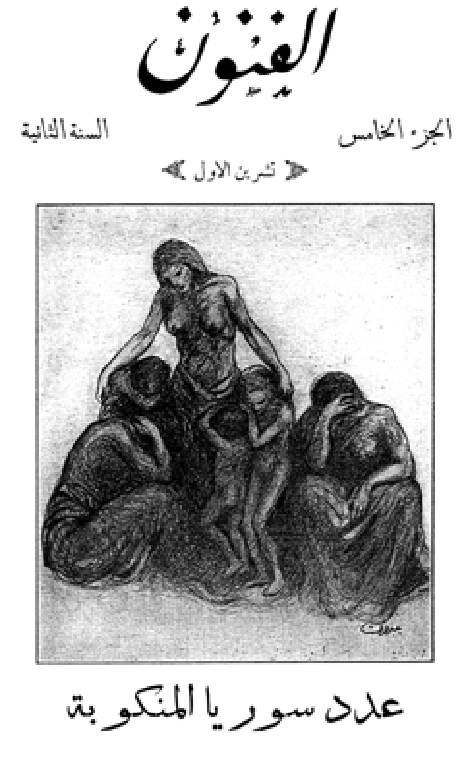| Special Editions were used only twice during al-Funun’s lifetime. One was devoted to the crisis in Syria (1916-1918) caused by famine and the other was devoted to the Arab Revolt and its leader al-Husayn the First (1918). Both editions exhibited art work and literary material that emphasized the topic of each special edition (2, no. 5 October 1917 and 3, no. 7 July 1918). For example, the cover to al-Funun shown at right, set the tone of the entire edition on the crisis in Syria. Even before the reader opened its covers, the orientation of the literary material was set. The reader knew that the journal would present the famine in figurative and emotional terms. Poems by William Catzeflis and Iliya Abu Madi, such as “Shakwa wa-Najwa” and “Fi al-Layl” respectively, along with Gibran’s “Mata Ahli,” combined with paintings and photographs humanized what was occurring in the homeland of al-Funun’s readership in terms they could understand. One of the main intents of this edition was to move the Arab-American readership to do something to aid their fellows in the old country. |

|
| The
edition devoted to the Arab Revolt took this one step further and encouraged
through its material the active participation in the Revolt, either physically
or materially. A number of Arab-Americans joined the Arab Army in Palestine
lead by British officers. This edition represented the Arab Revolt not
merely as a Muslim uprising against a tyrannical Ottoman Empire, but as
an Arab revolt comprised of both Christian and Muslim Arabs against a
repressive and reactionary regime that conspired to promote a division
between its subjects both religiously and nationally in order to control
the various groups within the Empire. The theme of Arab Nationalism, as
promoted in its early stages by Christian Arabs and as represented in
this edition of al-Funun, was a movement that wanted to create
an equality between Christians and Muslims before the eye of the law in
the Arab world, rather than the promotion of religious law that maintained
the Ottoman inspired (millet system) status quo. Go to Top of Page | Home Page | al-Funun | Image Directory | |
|